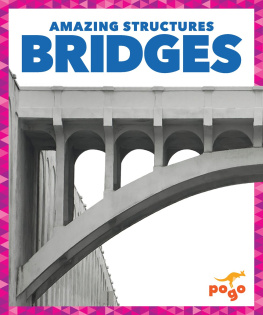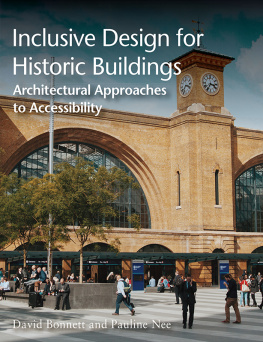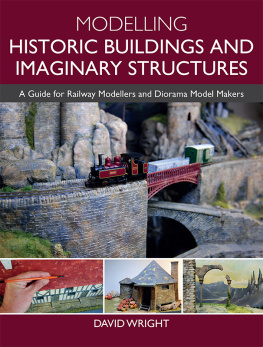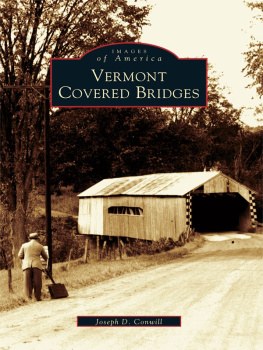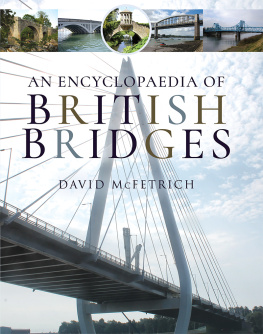David Yeomans - How Structures Work: Design and Behaviour from Bridges to Buildings
Here you can read online David Yeomans - How Structures Work: Design and Behaviour from Bridges to Buildings full text of the book (entire story) in english for free. Download pdf and epub, get meaning, cover and reviews about this ebook. year: 2016, publisher: Wiley, genre: Romance novel. Description of the work, (preface) as well as reviews are available. Best literature library LitArk.com created for fans of good reading and offers a wide selection of genres:
Romance novel
Science fiction
Adventure
Detective
Science
History
Home and family
Prose
Art
Politics
Computer
Non-fiction
Religion
Business
Children
Humor
Choose a favorite category and find really read worthwhile books. Enjoy immersion in the world of imagination, feel the emotions of the characters or learn something new for yourself, make an fascinating discovery.

- Book:How Structures Work: Design and Behaviour from Bridges to Buildings
- Author:
- Publisher:Wiley
- Genre:
- Year:2016
- Rating:4 / 5
- Favourites:Add to favourites
- Your mark:
- 80
- 1
- 2
- 3
- 4
- 5
How Structures Work: Design and Behaviour from Bridges to Buildings: summary, description and annotation
We offer to read an annotation, description, summary or preface (depends on what the author of the book "How Structures Work: Design and Behaviour from Bridges to Buildings" wrote himself). If you haven't found the necessary information about the book — write in the comments, we will try to find it.
David Yeomans: author's other books
Who wrote How Structures Work: Design and Behaviour from Bridges to Buildings? Find out the surname, the name of the author of the book and a list of all author's works by series.
How Structures Work: Design and Behaviour from Bridges to Buildings — read online for free the complete book (whole text) full work
Below is the text of the book, divided by pages. System saving the place of the last page read, allows you to conveniently read the book "How Structures Work: Design and Behaviour from Bridges to Buildings" online for free, without having to search again every time where you left off. Put a bookmark, and you can go to the page where you finished reading at any time.
Font size:
Interval:
Bookmark:
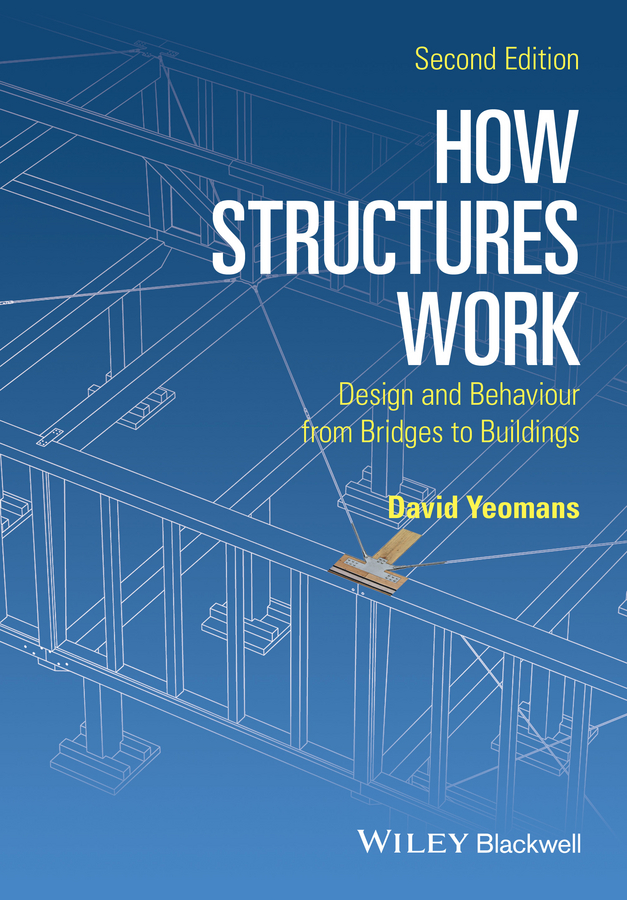
- Chapter 07
- Preface
- Chapter 01
- Chapter 02
- Chapter 03
- Chapter 04
- Chapter 05
- Chapter 06
- Chapter 07
- Chapter 08
- Chapter 09
- Appendix
Second edition
David Yeomans

This edition first published 2016
2016 David Yeomans
First edition David Yeomans 2009.
Registered Office
John Wiley & Sons, Ltd, The Atrium, Southern Gate, Chichester, West Sussex, PO19 8SQ, United Kingdom.
Editorial Offices
9600 Garsington Road, Oxford, OX4 2DQ, United Kingdom.
The Atrium, Southern Gate, Chichester, West Sussex, PO19 8SQ, United Kingdom.
For details of our global editorial offices, for customer services and for information about how to apply for permission to reuse the copyright material in this book please see our website at www.wiley.com/wiley-blackwell.
The right of the author to be identified as the author of this work has been asserted in accordance with the UK Copyright, Designs and Patents Act 1988.
All rights reserved. No part of this publication may be reproduced, stored in a retrieval system, or transmitted, in any form or by any means, electronic, mechanical, photocopying, recording or otherwise, except as permitted by the UK Copyright, Designs and Patents Act 1988, without the prior permission of the publisher.
Designations used by companies to distinguish their products are often claimed as trademarks. All brand names and product names used in this book are trade names, service marks, trademarks or registered trademarks of their respective owners. The publisher is not associated with any product or vendor mentioned in this book.
Limit of Liability/Disclaimer of Warranty: While the publisher and author(s) have used their best efforts in preparing this book, they make no representations or warranties with respect to the accuracy or completeness of the contents of this book and specifically disclaim any implied warranties of merchantability or fitness for a particular purpose. It is sold on the understanding that the publisher is not engaged in rendering professional services and neither the publisher nor the author shall be liable for damages arising herefrom. If professional advice or other expert assistance is required, the services of a competent professional should be sought.
Library of Congress Cataloging-in-Publication Data
Yeomans, David T.
How structures work : design and behaviour from bridges to buildings / David Yeomans. Second edition.
pagescm
Includes bibliographical references and index.
ISBN 978-1-119-01227-6 (pbk.)
1.Structural engineering. I.Title.
TA633.Y46 2015
624.1dc23
2015022633
A catalogue record for this book is available from the British Library.
Wiley also publishes its books in a variety of electronic formats. Some content that appears in print may not be available in electronic books.
Cover image: Cameron Scott
For Louise, Jane, Julia and my sister
The dedication of this book requires some explanation because, although it has been written to be suitable for architectural students, it was not originally conceived as such. The dedicatees include two archaeologists and an antiquarian book dealer. The idea for the book goes back further than I care to remember. Visiting an archaeologist friend, I picked up a book on Greek architecture, and it became apparent that the authors understanding of structure and construction lacked something. Dont you think, Louise, that it would be a good idea for archaeologists to learn something about building structures? Yes it would and so the seed was sown. The idea was simply that something on building structures might be useful for people with little or no mathematics but whose work or subject of study involves understanding buildings.
Many years later, Jane Grenville asked me if I could give some classes to her masters course on buildings archaeology at York University. Structures for archaeologists? Ive always wanted to try teaching that. And so the text for this began with the notes for that class. Working up the text into this form was pushed aside by other things until Julia, a dealer in antiquarian engineering books, said that she had asked the late Professor Skempton if he could teach her some structures. Hed claimed it would be difficult because the subject is highly mathematical. She thought this nonsense, pointing out that she frequently heard engineers discussing structures but they never used any mathematics. Of course, shes right; we seldom do when thinking about structures. The general experience is that one manages with a few simple concepts. Given the rule for static equilibrium, the triangle of forces and some ideas about moments and elasticity, one has the basic bag of tools that will cope with most situations. What one needs to add to this to make a designer, rather than a mere stress analyst, is an understanding of the properties of the materials that make up the structures we build, because no real understanding is possible without that. How then to provide the simple bag of tools? Goaded by Julias demands, I determined to tackle the problem.
What started as something for archaeologists, architectural historians or even the interested layperson (represented by my sister), and still remains suitable for that audience, was then developed at the suggestion of my commissioning editor to include material that would make it an architectural students text. Here, we see what might be described as a non-threatening approach to something that is normally seen as a highly technical subject, the idea for a method coming from my experience of starting to learn Spanish.
I was taught French and Latin at school, starting with the grammar; and that is how we commonly teach the theory of structures. We begin with the grammar and only apply it to real structures afterwards, the transition sometimes being difficult for students. Today, languages are often taught through communication. The Spanish teacher introduced herself in the first class with Me llamo Maria. Como te llamas? Tone of voice indicated a question, and one quickly grasped what the reply should be without realising one was using a reflexive verb a difficult piece of grammar because it is something that does not exist in English. Why then not teach structures in a similar way? Begin with simple structures that are easy to understand from common experience and build up the grammar, that is, the theoretical ideas, only as necessary. This might even be something that would appeal to engineers because it sometimes seems as if they have learnt a number of abstract concepts without grasping how they apply to real structures.
I only wish I had thought of this approach while I was teaching architectural students because no matter how simple we tried to make the subject for them they probably regarded structural analysis as a series of mind-numbing routines. The evidence was there in what I called my Christmas test. In the last class before the Christmas vacation I would present first-year students with a puzzle that I first came across in Meccano Magazine when I was 10 years old:
I have to weigh a lorry, but it is too long for the weighbridge. I put the front wheels on the weighbridge and take a reading. I then drive it forwards so that only the back wheels are on and take another reading. I add the two readings together. Do I have the weight of the lorry?
Next pageFont size:
Interval:
Bookmark:
Similar books «How Structures Work: Design and Behaviour from Bridges to Buildings»
Look at similar books to How Structures Work: Design and Behaviour from Bridges to Buildings. We have selected literature similar in name and meaning in the hope of providing readers with more options to find new, interesting, not yet read works.
Discussion, reviews of the book How Structures Work: Design and Behaviour from Bridges to Buildings and just readers' own opinions. Leave your comments, write what you think about the work, its meaning or the main characters. Specify what exactly you liked and what you didn't like, and why you think so.

